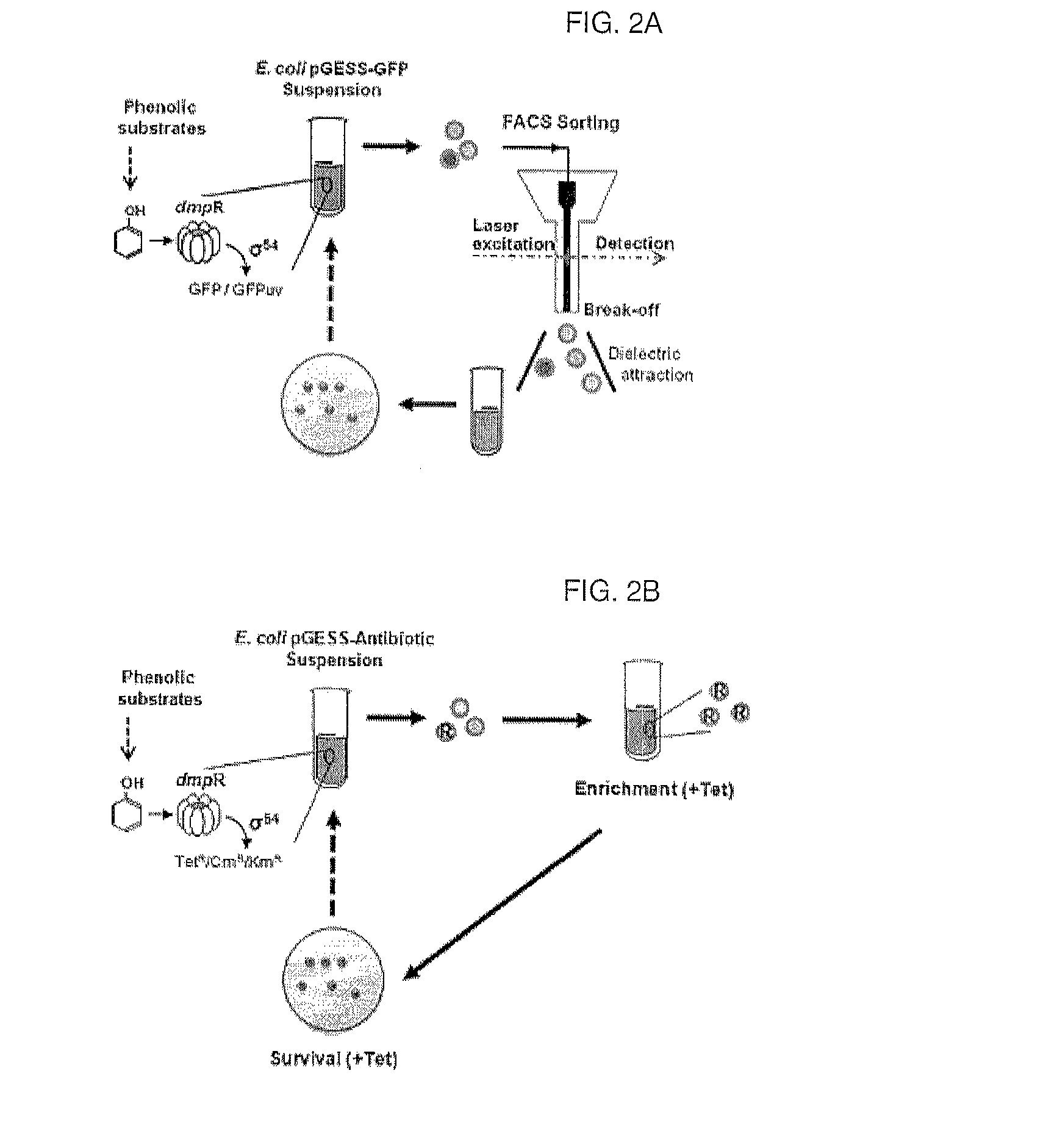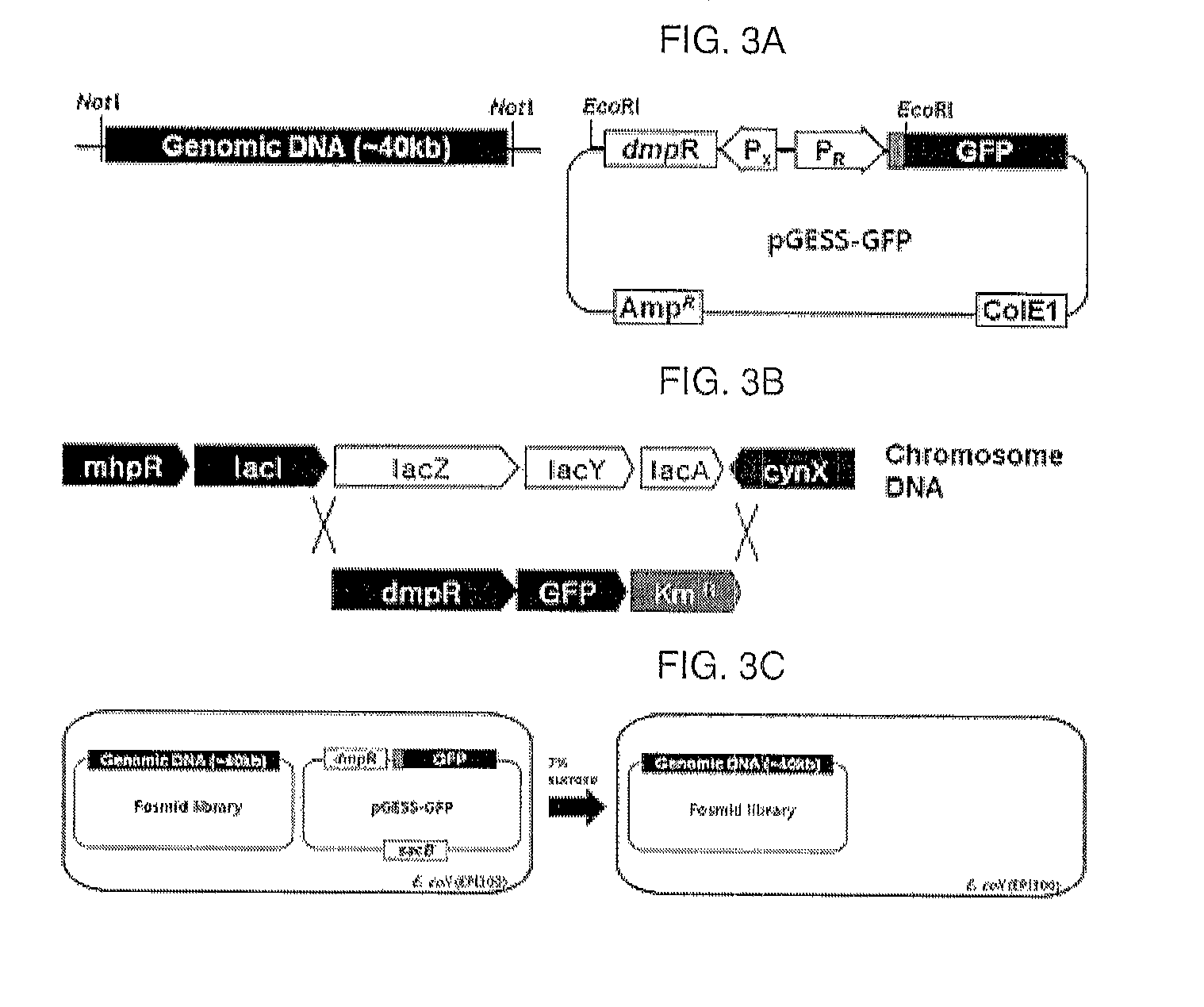Method for screening and quantifying various enzyme activities using a genetic enzyme screening system
a technology of enzymatic activity and screening system, which is applied in the field of screening and quantifying various enzymatic activity, can solve the problems of limited application of these methods, limited microbial species that can actually be cultured in laboratories, and limited application of genetic resources
- Summary
- Abstract
- Description
- Claims
- Application Information
AI Technical Summary
Benefits of technology
Problems solved by technology
Method used
Image
Examples
example 1
Construction of Artificial Genetic Circuit Based on the Expression Regulator dmpR Detecting Phenol
[0108]An artificial genetic circuit comprises a phenolic compound-degrading enzyme regulatory protein region, a gene expression regulatory region comprising promoters, and at least one reporter region selected from fluorescence proteins and antibiotic resistance genes.
[0109]An artificial genetic circuit (pGESS-FP) based on the plasmid pUC19 was constructed using Pseudomonas putida-derived phenol catabolic dmp operon as the phenolic compound-degrading enzyme regulatory protein detecting phenol, P. putida RBS as the region regulating the expression of the regulatory protein, and fluorescence protein (FP) as the reporter protein.
[0110]In the present invention, in order to construct the phenol-sensing artificial genetic circuit comprising EGFP (enhanced green fluorescence protein) gene as the reporter, a pMGFP plasmid (Ha et al., (2007) Appl. Environ. Microbiol. 73(22): 7408-7414) was diges...
example 2
Selection of Optimal Host E. coli for Artificial Genetic Circuit
[0122]In the present invention, in order for pGESS to operate as intended, Pseudomonas dmpR should be heterologously expressed at a suitable level and should smoothly interact with E. coli σ54-dependent transcriptional regulator (Sze et al., (1996) J. Bacteriol. 178(13): 3727-3735). Thus, the signal property of pGESS can vary depending on the biological properties and growth conditions of host microorganisms. In the present invention, in order to embody the phenol-sensing genetic circuit in a stable way, influences by i) the difference between host microorganisms and ii) the time point of induction of expression by the addition of phenol were examined to determine optimal conditions.
[0123]First, in this experiment, the phenol sensitivities of E. coli strains (DH5α, EPI300, JM109(DE3), BL21, and BL21(DE3)) containing the artificial genetic circuit were examined to select a suitable bacterial strain. Specifically, LB soli...
example 3
System Verification of Artificial Genetic Circuit and Quantitative Signal Analysis for Phenolic Compounds
[0125]1) Quantitative Analysis of Fluorescent Signal of Artificial Genetic Circuit for Phenol
[0126]In order to quantitatively analyze the function of the artificial genetic circuit (constructed in Example 1) to sense phenol, a single colony of recombinant E. coli BL21 containing pGESS-EGFP(I) was inoculated into LB liquid medium containing 50 μg / ml of ampicillin and was cultured with shaking overnight at 37° C. The culture was 106-fold diluted, and 100 μl of the dilution was plated on solid medium containing 50 μg / ml of amplicllin and 1-1000 μM phenol and was cultured 30° C. for 36 hours, after which the expression of fluorescence in the colony was observed with a fluorescence microscope. The fluorescence microscope was AZ100M (Nikon, Japan), and images were obtained using a CCD camera (DS-Qi1Mc, Nikon) and fluorescence filter set (GFP-HQ, Nikon) (Ex 455-485 nm, DM 495, BA 500-54...
PUM
| Property | Measurement | Unit |
|---|---|---|
| concentration | aaaaa | aaaaa |
| temperature | aaaaa | aaaaa |
| concentration | aaaaa | aaaaa |
Abstract
Description
Claims
Application Information
 Login to View More
Login to View More - R&D
- Intellectual Property
- Life Sciences
- Materials
- Tech Scout
- Unparalleled Data Quality
- Higher Quality Content
- 60% Fewer Hallucinations
Browse by: Latest US Patents, China's latest patents, Technical Efficacy Thesaurus, Application Domain, Technology Topic, Popular Technical Reports.
© 2025 PatSnap. All rights reserved.Legal|Privacy policy|Modern Slavery Act Transparency Statement|Sitemap|About US| Contact US: help@patsnap.com



